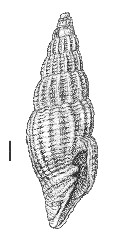
Revised descriptions of New Zealand Cenozoic Mollusca from Beu and Maxwell (1990)

 | Revised descriptions of New Zealand Cenozoic Mollusca from Beu and Maxwell (1990) | 
|
  (Pl. 25l): holotype, Pakaurangi Point, Kaipara Harbour, Otaian (TM1297, GNS) |
Beu & Maxwell (1990): Chapter 11; p. 231; pl. 25 l.
Synonymy: Uromitra neozelanica Laws 1939a, p. 495; Beu & Maxwell 1990, p. 231, pl. 25 l; Vexillum (Costellaria) neozelanica;
Classification: Costellariidae
Description: Size moderate for family (height 19-25 mm), fusiform, spire 0.6 total height. Protoconch imperfectly known, narrowly conical, of about 4 smooth whorls. Teleoconch of 7-8 whorls, spire whorls gently convex with strongly impressed sutures, last whorl broadly excavated with short neck. Axial sculpture of low, rounded or flattened, narrow costae of variable strength and spacing — even on an individual shell — reaching from suture to suture on spire whorls and across base of last whorl, typically becoming more obscure near outer lip; 14-32 costae on penultimate whorl. Spiral sculpture of low, flattened strap-like cords with much narrower interspaces, for the most part confined to the intercostal spaces —particularly on the spire whorls —barely surmounting axial costae on base and towards end of last whorl; 6-8 on penultimate whorl, an additional 5 or 6 on base; and 6-9 on neck, one of which near upper end is considerably broader than the others. Intersection of axial and spiral elements producing a strongly cancellate effect. Aperture rather small, pyriform; siphonal canal moderately long, weakly notched. Columella with 4 plaits decreasing in strength anteriorly. Inner lip thinly callused; outer lip finely lirate within.
Comparison: Costellaria etremoides (Altonian, Target Gully Shellbed, Oamaru) has much coarser and less numerous axial costae (seven to nine per whorl), much broader spaces between the spiral cords than C. neozelanica, and only three columellar plaits. Cernohorsky (1970a, p. 54) synonymised Uromitra Bellardi, 1887 with Costellaria Swainson, 1840, but Beu & Maxwell (1990, p. 231) separated Uromitra again from Costellaria. The wide range of characters, particularly shape, seen in the very diverse tropical Indo-West Pacific Recent species of Costellaria leaves no doubt that Uromitra is a synonym of Costellaria, and this synonymy was accepted by Maxwell (2009, p. 245). The warm-water genus Costellaria occurs only in Otaian to Clifdenian rocks of Clifden, Oamaru and Northland, apart from the Opoitian species C. caudata (Marwick, 1931), from the Gisborne district. C. caudata was assigned tentaively to Costellaria by Maxwell (2009), but seem to be correctly placed here.
Distribution: Otaian, Pakaurangi Formation, Pakaurangi Point, Kaipara Harbour (type) (rare). A shell from Te Pokere, Parengarenga Harbour (Altonian) differs in its finer spiral sculpture but may be conspecific.
Cite this publication as: "A.G. Beu and J.I. Raine (2009). Revised
descriptions of New Zealand Cenozoic Mollusca from Beu and Maxwell (1990). GNS
Science miscellaneous series no. 27."
© GNS Science, 2009
ISBN
978-0-478-19705-1
ISSN 1177-2441
(Included with a PDF facsimile file
copy of New Zealand Geological Survey Paleontological Bulletin 58 in CD version
from: Publications Officer, GNS Science, P.O. Box 30368 Lower Hutt, New
Zealand)